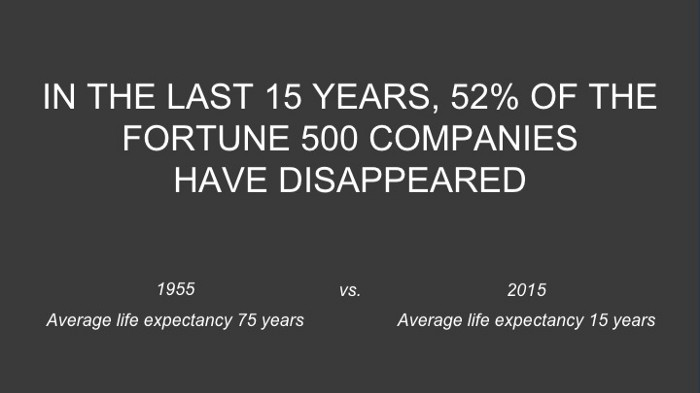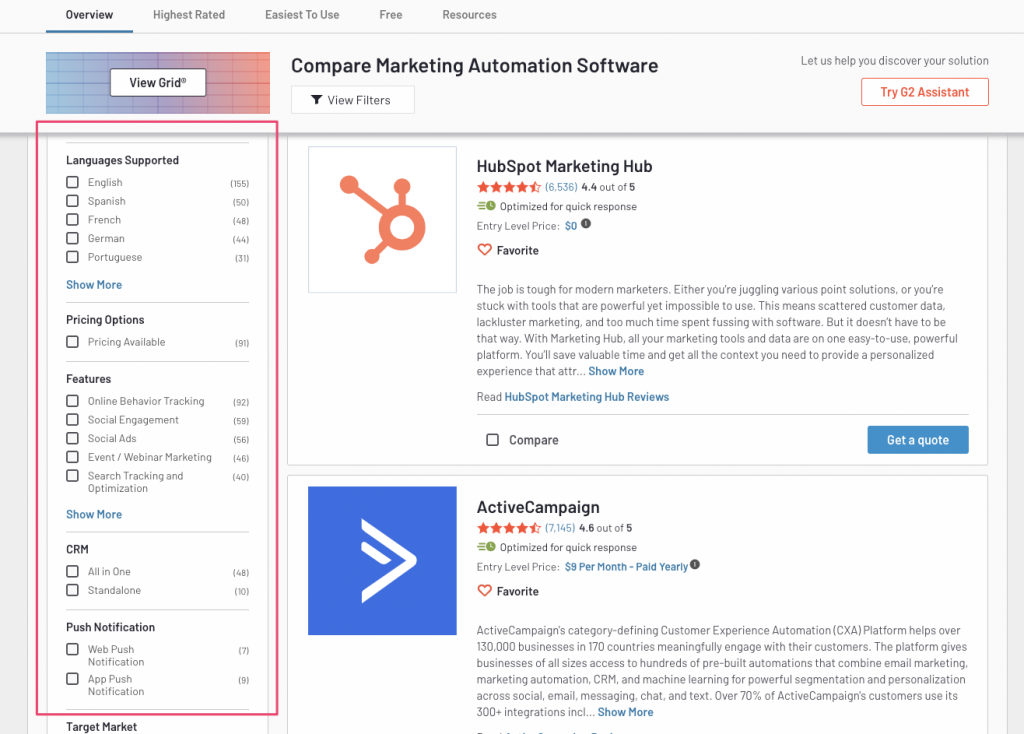
How to Modernize Your Marketing Legacy Systems: Evaluating & Adopting Your Tech Stack
Your marketing technology stack empowers your team to do great work. Generating impressive results not only becomes efficient, but enjoyable when the right tools are in place.
But for many organizations, their existing martech stack is more of a hindrance. Old-school technologies that have fallen behind get in the way, preventing great marketing talent from achieving great things.
In this article, we’ll help you make a case for modernizing your marketing legacy systems. You’ll learn about the benefits of modernization, how to sell your vision to the boardroom, the process for evaluating the right tools for your organization, and a strategy for digital adoption.
Modernizing legacy systems has become competitive table stakes
Adopting new tools and technologies for your marketing processes is about more than having shinier toys than your competition. Rather, it’s the bedrock of providing exceptional digital experiences for your customers.
This is what we mean by competitive table stakes. If your technology isn’t empowering you to delight your customer at every touch point, then it’s likely your competitors will do it for you. In fact, according to a study by PWC, 73% of consumers say a good experience is key in influencing their brand loyalties.
Because of this, modernizing the digital experience goes beyond marketing. It redefines the way your entire organization does business. Adopting the right tools help you:
- Personalize messaging to your customers based on their interests (and how they’ve engaged with your brand)
- Give customer success teams the power to respond to questions quickly
- Allow salespeople to better serve their leads and prospects
- Serve ads with messages that are relevant to the products that interest consumers
- Deliver content that most interests specific audience segments
Furthermore, it can uncover new potential revenue streams—something many businesses were forced to discover due to the impact of COVID-19. For example, fast-thinking retail stores quickly adopted new infrastructure for curb-side pick-up, allowing customers to order online and collect their goods without having to step into the store. They worked within the parameters of a new market and reacted accordingly.
Marketing modernization is about catering the customer experience to the expectations of today. Consumers (and B2B executives alike) have high expectations of the brands they do business with. Not only does digital adoption of this scale improve efficiency across the organization, but it makes stakeholders and investors happy thanks to metrics that move up and to the right.
But the process can be clunky—depending on the complexity of your existing systems. If implemented carelessly, new technologies can wreak havoc on your day-to-day operations and actually damage customer relationships.
Integrating vs. replacing your legacy systems
To avoid any downtime in marketing activity (and customer communication), it’s worth taking stock of your existing systems and how they integrate with other platforms.
Depending on your needs, it may be worth taking a phased approach by integrating new technologies with your existing legacy systems, rather than replacing them altogether.
For example, most CRM vendors have realized that, in order to stay relevant in a competitive market, they must allow for integration into other sales, marketing, and customer service platforms.
Taking a phased approach means figuring out the lay of the land, which you can accomplish by following a careful process:
- Figure out which of your systems are most embedded into your day-to-day work. Your CRM is one example, but what about helpdesk software and marketing automation?
- Investigate their integration capabilities. Most platforms have a marketplace of integration partners you can peruse. If you’re already evaluating other martech vendors, it’s wise to see if your existing legacy systems integrate with them.
- Look into data export. How easy is it to export and migrate your existing data? Can it be done manually, or do you need existing vendors to do it on your behalf? The answers to these questions will determine how smooth or clunky the process could be.
- Maximize the output of what you’ve already got. Consider how to apply existing systems in new ways.
- Decide whether you’ll replace or integrate your marketing legacy systems. Based on the answers to the steps above, make a data-driven decision fueled by research and a strategic digital roadmap.
You may find that you’re not getting everything you can out of your existing systems. It’s worth figuring out what your existing platforms’ true capabilities are before evaluating new technologies and taking the leap.
On the other hand, be wary of obsolescence. Depending on how old your systems are, you may find that you’ve re-invested in a platform that’s no longer supported by the vendor.
The true-north decision maker is this: do what’s right for your customers. If existing systems can provide consumers with what they want, more power to you. But if not, it’s time to move on.
Getting boardroom buy-in for digital adoption
So, you’ve decided to modernize your digital experience and committed to taking the leap. Problem is, you’re not the only person who needs convincing.
Marketing legacy system modernization can be a mammoth process that requires plenty of resources, which means getting buy-in from c-suite executives and senior decision makers is crucial to making progress.
Getting stakeholders on board is an entire process in itself. Luckily, there are frameworks you can use to produce a compelling argument.
Collect supporting data
Opinions don’t move decisions at the boardroom level. Even if you know modernization is the right thing to do, you need to make a solid case backed by data.
Collecting the right data can help you achieve two things:
- Paint a picture of the current state of your industry
- Make an argument for business outcomes
For example, if you’re working in the real estate industry, it’s worth nothing that 79% of renters have cancelled viewings based on negative reviews on social media and review sites.
This, coupled with the fact that 60% of consumers say they’d switch to a brand that offers superior customer service, and you have a strong case for investing in new technologies that enhance the customer experience.
When pitching to investors, subscription platform Zuora used data to dial up the pain and show how changes in the Fortune 500 was causing many of them to go out of business:

They then used examples to outline the opportunity that this change presents (along with quantifiable numbers):

Your data can demonstrate risk, but it should also outline opportunities you’re about to present to them.
Conduct a brief competitive analysis
Data and facts illustrate the current state of the world you’re operating in. But decisions are still made at an emotional level in some capacity, regardless of seniority.
Showing what the competition is up to (and how they’re providing good customer experiences) truly illustrates exactly how far you’ve fallen behind. It also hits c-suite executives in the gut with FOMO.
Present competitive analysis by following this process:
- Select two or three of your biggest competitors. You want to take a quality-driven approach and paint a detailed picture when making your case.
- Walk through the buyer journey as a customer. Interact with their brand, starting from the first touchpoint (e.g. social media content, ads, etc.) all the way to making a purchase or enquiry.
- Take notes and capture screenshots. Collect materials that specifically outlines what they do so well.
- Present your findings as a customer narrative. Use your deck to show patterns in what each competitor does, as well as the specific elements that you’re missing from your customer experience.
Dive deeper into marketing collateral, messaging, and channels that show what your company is missing out on. Most importantly, use it as a way to demonstrate what you can do differently (and better).
Remember, providing a delightful customer experience is competitive table stakes. Your goal is to surpass expectations and blow customers away. Running alongside the competition is a lukewarm effort, and you’ll find yourself in the same position 18 months down the road.
Outline projected KPI improvements
You’ve made your case and demonstrated what your marketing technology should empower you to do. Now it’s time to show the boardroom what this can help the organization to achieve.
Start by collecting and benchmarking your marketing KPIs from the last 12 months. Look at acquisition metrics and conversion rates across every channel and touchpoint.
For example, let’s say you have 34 landing pages that serve different customer segments across all product lines. How does the average conversion rate compare to industry benchmarks? What are your highest and lowest performing landing pages, and how could you improve performance with the right technologies?
The same goes for email marketing. How well does your current platform allow you to segment customer segments and personalize messaging to their interests?
Once you’ve collected historical data, look for other studies that support potential increases in conversions. For example, according to this study from Experian, personalized emails deliver 6x higher transaction rates than those that aren’t personalized.
While there are several factors at play, you can use this data to extrapolate the potential increase in email ROI. It’s only a leading indicator, but one that tells a powerful story.
Bringing all three of these elements into play—data, competitive analysis, and projections—will help you make a strong case to the boardroom. Show them what they’re missing out on, and how your plan for marketing maturity will help everyone across the organization get better results.
Evaluating the right tools against new and existing processes
Once you’ve made a case, you need to find the right tools for the job. As of 2020, there were over 8,000 martech vendors in the market—a 13.6% increase from the previous year.
The sheer number of options can make finding the right provider tricky. Here are a few approaches to finding best-in-class marketing technology for your modernization efforts:
1. Start with review sites like G2 and Capterra
G2 and Capterra have already done some of the hard work for you. These review sites act as a software database segmented by category, with ratings from users who use them on a daily basis.
Furthermore, they provide filters within each category, allowing you to find potential vendors based on your early requirements:

2. Put together a requirements document
To evaluate vendors, you need something to measure them against. This one is the simplest (but perhaps most time-consuming) part of the process: creating a requirements document.
Start with a simple statement that briefly outlines what you’re aiming to achieve with your new technologies. For example, if you’re looking to adopt new email marketing automation software, this statement might be:
“Our chosen email automation platform must be able to segment customers by interests and behavior, allowing us to send targeted messaging for every campaign and trigger emails based on their behavior.”
Short, simple, and to the point. This sets the tone and keeps you in check as you go through the evaluation process. From here, you must create a list of technical and onboarding requirements. This includes specific features, as well as initial support during the first few months of implementation.
If this is a replacement exercise (e.g. you’re looking for a new CRM to replace your current one), make sure that data migration is hassle-free. At the very least, your new vendor should be able to assist in doing this for you.
3. Set a clear budget
How much are you willing (and able) to spend on a monthly or annual basis? This step requires more input from the boardroom, as it’s likely you’ll need their financial support beyond the quarterly budgets you’ve been allocated.
It’s far easier to make a case when you demonstrate the potential returns. So, while having a budget in mind is key, make sure you also detail any potential increases in conversions or reductions in costs (from a technical and people power perspective).
4. Schedule demos and evaluate your options
With a list of potential tools and clear expectations, it’s time to find out what each vendor is all about. The evaluation process will depend on your needs, but typically the steps are as follows:
- Demo request. A guided walkthrough of the tool or platform. Decent sales reps will tailor demos to your needs, focusing on the features that you’ve outlined in your requirements document.
- Sales materials. Decks, ebooks, technical documentation, and other sales collateral should be shared with everyone involved in the process.
- Trial. Get your hands on the tool and give it a test drive. Depending on the scale of the project, this will allow you to get a feel for what you can expect when rolling out across your entire organization.
- Negotiate. Go over timelines, and get commitment on onboarding activity and initial support.
These steps (or a variation of them) should give you everything you need to make a decision. Get the input of everyone involved in the process—especially individual contributors, as they’ll be interacting with the tools on a daily basis.
How to roll out a marketing modernization without disruption
Speaking of individual contributors, the next step is to implement and integrate your new platforms with minimum disruption to their work.
The best way to do this is with a phased approach. Instead of uprooting existing tools, start rolling out to different areas of the business.
Prioritize each phase based on the customer journey
You can start this process by first mapping the customer journey and the relevant touchpoints across every interaction. Don’t try to do everything at once.
Instead, figure out how to replace and roll out one channel at a time. For example, you could first migrate email workflows for customer retention activity, followed by cart abandonment emails, newsletters, etc.
Prioritize which areas of the digital experience need migrating first, creating timelines that every department and stakeholder must adhere to.
Collaborate with other departments
Speaking of other departments, it’s critical you get their input on the implementation plan. For example, if your events marketing team depends on your legacy system to execute on a campaign 30 days from now, you’ll need to work to their timescales in order to avoid disruption.
Encourage them to provide input on priorities and how features are implemented. They’ll be able to present ideas on how certain features can be deployed or changed, allowing them to contribute to building a stronger customer experience across the board.
Create detailed training & documentation
The added benefit of taking a phased approach is that it makes documentation easier to manage. As you migrate various parts of the customer experience to your new platform, you can document as you go along without overwhelm.
This can then be accompanied by internal training. You can do this as live workshops, or asynchronously thanks to tools like Loom.
It all comes down to clear processes. Documentation should provide easy-to-follow steps and an order of operations that ensures copy, creative, and marketing collateral is executed without error. This is especially critical when using new tools for the first time, as you’d be surprised how easy it is to accidentally send emails with missing variables.
Nobody likes being addressed as “{{first_name}}.”
Communicate changes to existing customers
Finally, be sure to clearly communicate any changes that directly affect your customers. For example, if you’re migrating to a new ecommerce platform, customers will need to re-enter their credit card information the next time they make a purchase.
Another, more complex example involves implementing a new healthcare CRM and patient management tool. Here, it’s critical you make patients aware of the process changes to avoid confusion.
Many modern tools allow for automated communications such as text message appointment confirmations or patient portals for providing results. Inform your new and existing patients of the new protocols, what they will need to do (e.g. create a username and password for a patient portal) along with any other expectations.
It’s important to get ahead of barriers to a seamless transition to avoid grievances and ensure a smooth transition.
Key takeaways
Depending on how far your organization has fallen behind, a digital maturity strategy might be the right call. However, don’t pull the trigger until you’ve taken stock of your existing platforms.
Can your legacy marketing systems integrate with other best-of-breed tools? Are there any features with untapped potential? If the answer is yes, an integration might be the best approach.
However, if your existing platforms are preventing you from delivering a mind-blowing customer experience, it’s time to move on. The decision should always come down to what’s best for your customer.
SUBSCRIBE TO OUR BLOG DIGEST!
Submit this form to receive a monthly, curated digest of our blogs, filled with helpful thought leadership, innovative trends and industry insights, all delivered straight to your inbox.